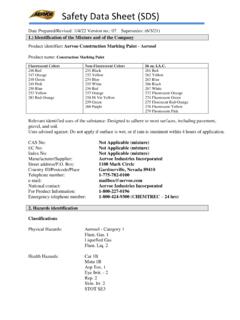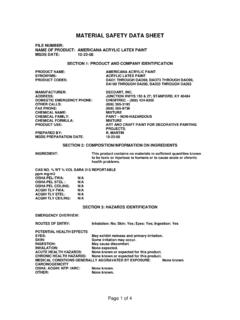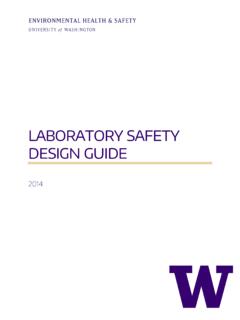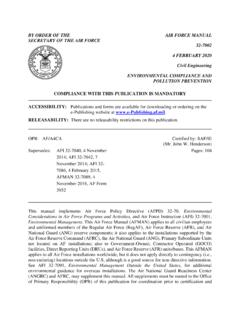Transcription of Safety Data Sheet: P-80® Emulsion
1 SECTION 1: identifierTrade nameP-80 identified uses of the substance or mixture and uses advised againstRelevant identified usesLubricantsIndustrial useDo not use for private purposes (household) of the supplier of the Safety data sheetInternational Products Corporation201 Connecticut DriveBurlington, NJ08016 United +1 6093868770e-Mail (competent person) informationManufacturerNameStreetPostal code/cityCountryTelephonee-MailWebsiteIn ternationalProducts Corpor-ation201 ConnecticutDrive08016 BurlingtonUnited telephone information service1-609-386-8770 This number is only available during the followingoffice hours: Mon-Fri 08:00 AM - 04:30 PM, EasternTimeSECTION 2: Hazard(s) of the substance or mixtureClassification acc. to OSHA "Hazard Communication Standard" (29 CFR )This mixture does not meet the criteria for elementsLabelling acc. to OSHA "Hazard Communication Standard" (29 CFR )not requiredSafety Data Sheetacc.
2 To 29 CFR App DP-80 EmulsionTemporary Rubber Assembly LubricantDate of issue: January 1, 2021 Replaces version of April 1, 2020 United States: enPage: 1 / hazardsResults of PBT and vPvB assessmentThis mixture does not contain any substances that are assessed to be a PBT or a 3: Composition/information on relevant (mixture) of the mixtureName of substanceIdentifierWt%Classification acc. to GHSP ictograms2-methylisothiazol-3(2H)-oneCAS No2682-20-40 < Tox. 3 / H301 Acute Tox. 3 / H311 Acute Tox. 2 / H330 Skin Corr. 1B / H314 Eye Dam. 1 / H318 Skin Sens. 1A / H317 Aquatic Acute 1 / H400 Aquatic Chronic 2 / H411 SECTION 4: First-aid of first-aid measuresGeneral notesDo not leave affected person unattended. Remove victim out of the danger area. Keep affected person warm, still andcovered. Take off immediately all contaminated clothing. In all cases of doubt, or when symptoms persist, seek medicaladvice.
3 In case of unconsciousness place person in the recovery position. Never give anything by inhalationIf breathing is irregular or stopped, immediately seek medical assistance and start first aid actions. Provide fresh skin contactWash with plenty of soap and ingestionRinse mouth with water (only if the person is conscious). Do NOT induce important symptoms and effects, both acute and delayedSymptoms and effects are not known to of any immediate medical attention and special treatment needednoneSafety Data Sheetacc. to 29 CFR App DP-80 EmulsionTemporary Rubber Assembly LubricantDate of issue: January 1, 2021 Replaces version of April 1, 2020 United States: enPage: 2 / 10 SECTION 5: Fire-fighting mediaSuitable extinguishing mediaWater spray, BC-powder, Carbon dioxide (CO2)Unsuitable extinguishing mediaWater hazards arising from the substance or mixtureHazardous combustion productsNitrogen oxides (NOx), Carbon monoxide (CO), Carbon dioxide (CO2) for firefightersCoordinate firefighting measures to the fire surroundings.
4 Do not allow firefighting water to enter drains or watercourses. Collect contaminated firefighting water separately. Fight fire with normal precautions from a reasonable 6: Accidental release precautions, protective equipment and emergency proceduresFor non-emergency personnelRemove persons to emergency respondersWear breathing apparatus if exposed to vapors/dust/ precautionsKeep away from drains, surface and ground water. Retain contaminated washing water and dispose of and material for containment and cleaning upAdvice on how to clean up a spillWipe up with absorbent material ( cloth, fleece). Collect spillage: Sawdust, Kieselgur (diatomite), Sand, Universal bind-erAppropriate containment techniquesUse of adsorbent to other sectionsHazardous combustion products: see section 5. Personal protective equipment: see section 8. Incompatible materials:see section 10.
5 disposal considerations : see section 7: Handling and for safe handlingRecommendations- Measures to prevent fire as well as aerosol and dust generationUse local and general ventilation. Use only in well-ventilated Data Sheetacc. to 29 CFR App DP-80 EmulsionTemporary Rubber Assembly LubricantDate of issue: January 1, 2021 Replaces version of April 1, 2020 United States: enPage: 3 / 10 Advice on general occupational hygieneWash hands after use. Do not eat, drink and smoke in work areas. Remove contaminated clothing and protective equip-ment before entering eating areas. Never keep food or drink in the vicinity of chemicals. Never place chemicals in con-tainers that are normally used for food or drink. Keep away from food, drink and animal for safe storage, including any incompatibilities- Specific designs for storage rooms or vessels- Storage temperatureRecommended storage temperature: 2 30 CSECTION 8.
6 Exposure controls/personal parametersThis information is not DNELs of components of the mixtureName of substanceCAS NoEndpointThresholdlevelProtection goal,route of exposureUsed inExposure time2-methylisothiazol-3(2H) mg/m human, inhalatoryworker (industry)chronic - local ef-fects2-methylisothiazol-3(2H) mg/m human, inhalatoryworker (industry)acute - local effectsRelevant PNECs of components of the mixtureName of substanceCAS NoEndpointThresholdlevelOrganismEnvironm entalcompartmentExposure time2-methylisothiazol-3(2H) g/laquatic organismsfreshwatershort-term (singleinstance)2-methylisothiazol-3(2H) g/laquatic organismsmarine watershort-term (singleinstance)2-methylisothiazol-3(2H) mg/laquatic organismssewage treatmentplant (STP)short-term (singleinstance)2-methylisothiazol-3(2H) mg/kgterrestrial organismssoilshort-term (singleinstance) controlsAppropriate engineering controlsGeneral protection measures (personal protective equipment)Eye/face protectionWear eye/face Data Sheetacc.
7 To 29 CFR App DP-80 EmulsionTemporary Rubber Assembly LubricantDate of issue: January 1, 2021 Replaces version of April 1, 2020 United States: enPage: 4 / 10 Skin protection- Hand protectionWear suitable gloves. Chemical protection gloves are suitable, which are tested according to EN 374. Check leak-tight-ness/impermeability prior to use. In the case of wanting to use the gloves again, clean them before taking off and airthem well. For special purposes, it is recommended to check the resistance to chemicals of the protective gloves men-tioned above together with the supplier of these Other protection measuresTake recovery periods for skin regeneration. Preventive skin protection (barrier creams/ointments) is hands thoroughly after protectionIn case of inadequate ventilation wear respiratory exposure controlsUse appropriate container to avoid environmental contamination.
8 Keep away from drains, surface and ground 9: Physical and chemical on basic physical and chemical propertiesAppearancePhysical stateliquidColorwhite-opaqueOdorcharacte risticOther Safety parameterspH (value)8 point/freezing pointnot determinedInitial boiling point and boiling range100 CFlash pointnot determinedEvaporation ratenot determinedFlammability (solid, gas)not relevant, (fluid)Explosive limitsnot determinedVapor pressurenot g/cm Vapor densitythis information is not availableSolubility(ies)not determinedSafety Data Sheetacc. to 29 CFR App DP-80 EmulsionTemporary Rubber Assembly LubricantDate of issue: January 1, 2021 Replaces version of April 1, 2020 United States: enPage: 5 / 10 Partition coefficient- n-octanol/water (log KOW)this information is not availableAuto-ignition temperaturenot determinedViscositynot determinedExplosive propertiesnoneOxidizing propertiesnoneSECTION 10: Stability and incompatibility: see below "Conditions to avoid" and "Incompatible materials".
9 StabilityThe material is stable under normal ambient and anticipated storage and handling conditions of temperature and pres-sure. Shelf-life: Two years from the date of of hazardous reactionsNo known hazardous to avoidDo not mix with other materialsAvoid extended contact with uncured paint, zinc, aluminum, cold rolled steel, or copper and its alloys. Avoid contact withpolycarbonate, polymethyl methacrylate, and polyphenylene oxide as these plastics may craze over time. Refer toproduct s compatibility sheets for further decomposition productsReasonably anticipated hazardous decomposition products produced as a result of use, storage, spill and heating are notknown. Hazardous combustion products: see section 11: Toxicological on toxicological effectsBasis of test procedureThe classification is based on tested acc. to OSHA "Hazard Communication Standard" (29 CFR )This mixture does not meet the criteria for toxicityShall not be classified as acutely Data Sheetacc.
10 To 29 CFR App DP-80 EmulsionTemporary Rubber Assembly LubricantDate of issue: January 1, 2021 Replaces version of April 1, 2020 United States: enPage: 6 / 10 Acute toxicity estimate (ATE) of components of the mixtureName of substanceCAS NoExposure routeATE2-methylisothiazol-3(2H)-one2682 -20-4oral120 mg/kg2-methylisothiazol-3(2H)-one2682-20 -4dermal242 mg/kg2-methylisothiazol-3(2H)-one2682-20 -4inhalation: mg/l/4hSkin corrosion/irritationShall not be classified as corrosive/irritant to eye damage/eye irritationShall not be classified as seriously damaging to the eye or eye or skin sensitizationShall not be classified as a respiratory or skin cell mutagenicityShall not be classified as germ cell not be classified as toxicityShall not be classified as a reproductive target organ toxicity - single exposureShall not be classified as a specific target organ toxicant (single exposure).






